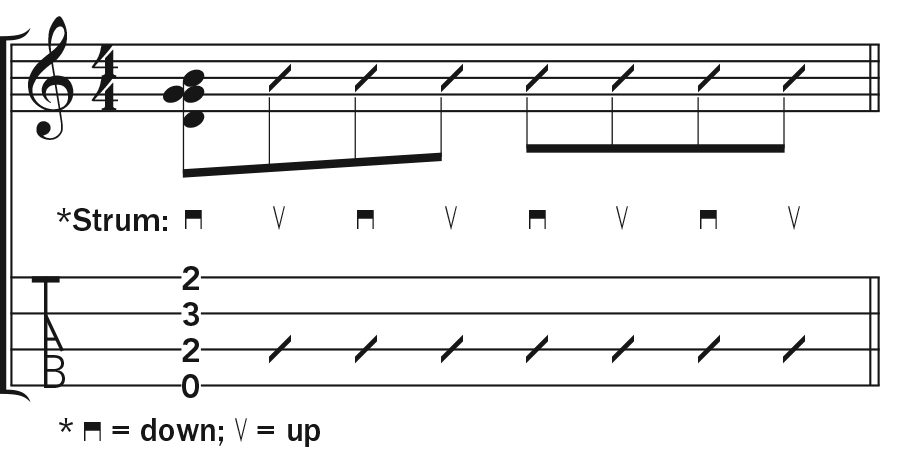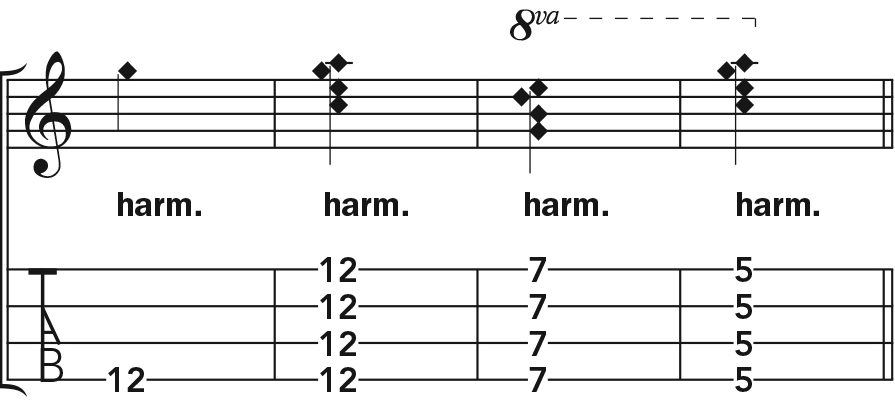How to Read Ukulele Music: Your Guide to Understanding Musical Notation

BY ADAM PERLMUTTER
For the uninitiated, music notation can look less like musical symbols than birds on a telephone wire or insects crawling on a page—inscrutable information that they haven’t a clue what to do with. But many who read notation find it an invaluable tool for learning new music and sharing it with others, while getting to better know their instruments. Here’s how to read ukulele music and understand musical notation.
To get the most from this magazine, which is packed with music for songs and lessons in each issue, you don’t have to become a virtuosic sight-reader. But it would be a good idea to have at least a little understanding of how notation works. As with guitar and other fretted instruments, ukulele notation is typically conveyed in several ways—through the standard staff notation that any trained musician can read, and by tablature and chord frames, which are ukulele- and even tuning-specific.
Here’s a comprehensive primer, covering all of the notational aspects you’ll typically find on these pages, for any type of ukulele. For handy reference, download a free PDF of the notation guide here. Devote a portion of your practice time to learning how notation works—and reading new music—and those strange symbols will become rich with musical information.
Standard Notation
Standard notation is written on a five-line staff, with notes in alphabetical order, from A to G. Every time you pass a G, the sequence of notes repeats, starting with A.

The duration of a note is determined by three elements: the note head, stem, and flag. A whole note (w) equals four beats. A half note ( h ), as the name suggests, is half of that: two beats. A quarter note (q) is one beat; an eighth note ( e ), half of a beat; and a 16th note (x), a quarter beat (four 16th notes per beat).

A fraction (4/4, 3/4, etc.) at the beginning of a piece of music—or at any other point within the tune—denotes the time signature. The top number tells you how many beats are in each measure, and the bottom number indicates the rhythmic value of each beat (4 = quarter note, 8 = eighth note, 2 = half note, etc.). You’ll most often encounter ukulele music written in 4/4 time—four quarter notes per measure, also known as common time, sometimes expressed with a [c] symbol. The symbol that looks like a “c” with a vertical line through it stands for cut time—that’s two half notes per bar, a meter used for fast tempos. Waltz time or 3/4 (three quarter notes per measure) is another common meter in the ukulele literature.

Chord Diagrams
Chord diagrams (a.k.a. frames or grips) offer a quick and easy way for players of all levels to read music. In a chord diagram, vertical lines represent the ukulele’s strings—left to right, strings 4 through 1—while frets are shown as horizontal lines. A thick top line represents the instrument’s nut; if that line is thin, it represents a fret, the number of which is indicated to the right of the frame. Dots within the grid show you where to place your fingers on the fretboard, and numbers above the frame suggest fingers to use (1 = index finger, 2 = middle, 3 = ring, and 4 = pinky). Meanwhile, 0 calls for a string to be played open and X calls for it to be silenced or not played.

Here are four common ukulele voicings. Note that the last frame uses a thick horizontal line to represent a barre—a single finger laying across and depressing multiple strings—in this case with the first finger depressing strings 1 and 2 at fret 3.

Tablature
Tablature is another notational form often used for fretted instruments. It uses four horizontal lines to represent the four strings of the ukulele, with the first string on the top and the fourth on the bottom. The numbers refer to the frets to be played on given strings.

The relationship between the notation and the tablature will vary, depending on what type of uke you’re playing. In reentrant (or high G), the tuning most commonly used in Ukulele, on a soprano, concert, or tenor uke, the notation of the open strings will look like shown below. Low G, in which the fourth string is an octave lower, making the four strings fall in consecutive pitch order, is depicted in the next measure. The baritone uke is tuned to the same notes as the top four strings of the guitar, as shown in the third bar. Note that while the guitar sounds an octave lower than written in standard notation, the baritone uke is often written at pitch.
The standard notation and tablature in Ukulele is designed for tandem use—you can get the rhythmic information from the former and fretting-finger placement from the latter.

Fingerings
Just as with chord frames, fretting-hand fingerings are sometimes suggested with small numbers in notation. Picking-hand fingerings are often depicted between the standard and tablature staves using a letter to represent each finger: p represents the thumb, i the index finger, m the middle, and a the ring. Remember that the fingerings in notation are only suggestions; if you find a way that works better for you, always feel free use it.
Advertisement

In music that is strummed or played with a pick, downstrokes (toward the floor) and upstrokes (toward the ceiling) are shown as follows. Slashes in the notation and tablature indicate to continue strumming the previous chord—in this case, G.

Capos
If a capo is used, a Roman numeral indicates the fret where it should be placed. The standard notation and tablature are written as if the capo were the nut of the guitar. For instance, a tune played using key-of-G chord shapes and fingerings will be written in the key of G, regardless of where the capo is placed. Likewise, open strings held down by the capo are written as open strings. In this example, the music is played in G with a capo at the second fret, causing it to sound a whole step higher than written, in the key of A major.

Tunings
Unless otherwise specified, the music in ukulele is in standard reentrant tuning, string 4 to string 1, G C E A. If a piece is in an alternate tuning like G C E G or G B D G, that information is shown immediately before the notation. In these tunings, the notation reflects the actual pitches of the notes. But if the ukulele is placed in a tuning in which the strings maintain the same relationship to each other—for instance, lowered by a half step (F# B D# G#)—then the pitches are written as if played in standard tuning.
Articulations
There are a number of ways to articulate a note on the ukulele. Two or more different notes connected with slurs (curved lines, not to be confused with ties, which link notes of the same pitch) in standard notation and tab can be played with hammer-ons and/or pull-offs. Lower notes slurred to higher ones are played as hammer-ons; higher to lower, as pull-offs.

A slide is fretting-hand articulation represented by a slanted line. If the line precedes the note, that note should be slid into from an indefinite, lower point; if it follows the note, slide down. The direction of the slide is dictated by the orientation of the line. For example, slide up into the seventh-fret B in bar 1, and down out of that note in the next measure. For a legato slide—two or more notes connected with a slide, as shown in bars 3 and 4—pick the first note and then slide into the other(s).

A grace note—a quick ornament leading into a note, most commonly played with some type of slur—is represented by a small note with a dash through the stem in standard notation, paired with a small number in tab. In the first example below, pick the note at the fifth-fret F on the beat, then quickly hammer onto the seventh-fret G. The second example is executed as a quick pull-off from the second-fret B to the open A string. In the third example, the open A and E strings are played simultaneously (even though it appears that the A is to be played by itself), then the third-fret C fret is immediately hammered.

Harmonics
Natural harmonics are chime-like sounds produced by gently touching the strings directly above the fretwire, without pressing down. Harmonics are represented by diamond-shaped notes in standard notation and regular numbers in tab, paired with the text indication harm. On the ukulele, harmonics are most commonly played at the frets 12, 7, and 5, as shown below.

Repeats
The navigational devices used to convey repeated music in a score can be a major source of confusion. Repeat symbols are placed at the beginning and end of a passage to be repeated, as shown below. You should ignore the forward repeat symbol (with the dots on the right side) the first time you encounter it; when you come to a backward repeat symbol (dots on the left side), jump back to the forward repeat. The next time you come to the backward repeat, ignore it and keep going unless you see instructions like “play three times.”

A section will often have a different ending after each repeat, like shown in the example below. Play until you hit the backward repeat at the first ending (through bar 2), then jump back to the forward repeat in bar 1, and play through that measure again. After that, skip bar 2 (the first ending), go straight to the second ending (bar 3), and continue (not shown in notation).

D.S. stands for dal segno or “from the sign.” It’s usually indicated with an instruction like D.S al Coda, which simply tells you to return to the music at the sign and continue until you are instructed to jump to the coda [fi] As shown here in notation, play through bar 5 and then, as directed by D.S. al Coda, go to the sign at bar 2. Play until you see the instruction To Coda (at the end of bar 3), then move to the coda (bar 6).

D.C. stands for da capo or “from the beginning.” Go to the top of the piece when you encounter this indication. Fine means ending, so D.C al Fine tells you to return to the beginning of a piece, and then play until you see the indication Fine, ending the piece. For instance, after you’ve navigated through bar 6 below, go back to bar 1 and play through the end of bar 2.
Advertisement
Note that in general, both D.S. and D.C. can be used with either al Coda or al Fine, and that there can be multiple signs and codas within a piece.

If all these D.S.s and D.C.s still seem like gibberish to you, not to worry. Just as with learning to strum chords and play melodies, it will take a little effort to learn notation. But once you’ve spent enough time with it, you’ll be able to sail through music with ease—in real time, without having to look up what those symbols mean.
For handy reference, download a free PDF of this notation guide.

The Ukulele Owner’s Manual is the book that belongs in every ukulele player’s instrument case. Each chapter was written by the experts and performers at Ukulele Magazine, with topics ranging from commonsense instrument care to fixing rattles and buzzes to a pictorial history of the instrument. Book owners can also download how-to videos with step-by-step guidance on common set-up and maintenance topics.

Ukulele Basics – Learning and Practicing is a great resource for players just starting out, as well as those looking to build a more solid foundation of knowledge and skills. Get your copy today at store.ukulelemag.com.


